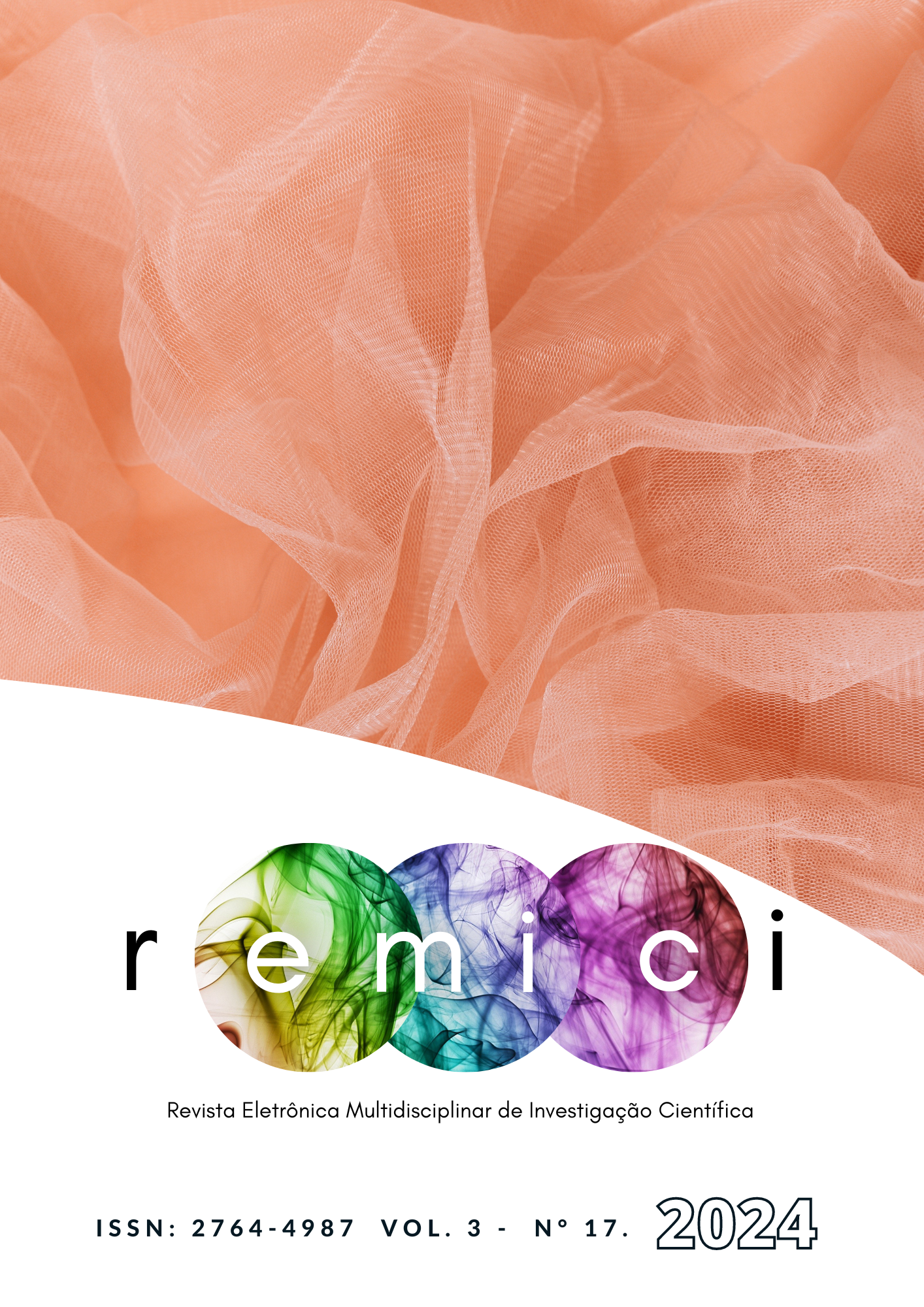CARACTERIZAÇÃO DAS FERIDAS COMPLEXAS EM PACIENTES INTERNADOS NO HOSPITAL DAS CLÍNICAS DE BOA VISTA/RR, BRASIL, NO PERÍODO DE JANEIRO ATÉ JUNHO DE 2022
Main Article Content
Abstract
Complex wounds are an important health problem for society due to the repercussion of skin injuries on the body and on relationship life, causing physical impacts, the psycho-emotional impacts and the socioeconomic consequences caused by long-term hospitalizations. This quantitative, descriptive and cross-sectional research aims to characterize the behavior of complex wounds in patients with this type of injury, from January to June 2022. The sample is patients with complex wounds who were admitted to the Hospital das Clínicas de Boa Vista/RR, Brazil, for a period of more than 24 hours. The data were collected from the documentary analysis of the production sheet of the Wound Treatment Nursing Center and the patients' records, including the dressing sheets attached to these records, complemented by information from the Medical Archive and Statistics Service (SAME) of the Clinical Hospital. The recording sheet was prepared considering the demographic, epidemiological and clinical data of the wounds, for collection and information, containing the different variables of the research object. The average age of the patients was 56.4 years, with male patients predominating (67.6%). The majority were from the state capital (79.4%), and were mainly single (39.8%). The patients had low education and low income. 86.9% of patients were admitted for clinical treatment. 92.8% did not diet and 91.6% of patients did not exercise. The length of stay had an average of 37.6 days. We found diabetic wounds, associated with Diabetes Mellitus, with 48% of cases, followed by vascular ulcers and pressure ulcers.
Article Details

This work is licensed under a Creative Commons Attribution-NonCommercial-ShareAlike 4.0 International License.
References
ALMEIDA, W. A. et al. Fatores associados a qualidade de vida de pessoas com feridas complexas crônicas. Journal of Research: Fundamental Care Online, v. 10, n. 1, p. 9-16. 2018. Disponível em: https://pesquisa.bvsalud.org/portal/resource/pt/biblio-908403. Acessado em: Dez. 2022.
BRASIL. Ministério da Saúde. Secretaria de Políticas de Saúde. Manual de condutas para feridas complexas. Brasília: Ministério da Saúde, p. 56. 2002.
BRASIL. Ministério da Saúde. Secretaria de Assistência à Saúde. Manual de Brasileiro de acreditação Hospitalar. Brasília: Ministério da Saúde, 2002.
BRASIL. Secretaria de Vigilância Epidemiológica. Vigilância de doenças e agravos não transmissíveis. Brasília: Ministério da Saúde, 2004.
BERRI, D. T. et al. Experiência do grupo de feridas complexas da disciplina de cirurgia plástica do Hospital de Clínicas e Hospital do Trabalhador de Curitiba. Arquivos Catarinenses de Medicina, Curitiba, v. 41, n. 1, 2012. Disponível em: http://www.acm.org.br/revista/pdf/artigos/1195.pdf. Acessado em: Dez. 2022.
BLANES, L. Tratamento de feridas. In: BAPTISTA-SILVA, J. C. C. (Ed.). Cirurgia vascular: guia ilustrado. São Paulo.2004. Disponível em: http://www.bapbaptista.com. Acesso em: Nov. 2022.
DEALEY, C. Cuidando de feridas: um guia para as enfermeiras. São Paulo: Atheneu, 2008.
DÂNGELO, J. G.; FATTINI, C. A. Anatomia humana básica. São Paulo: Editora Atheneu, 2009.
FARINA, J. A.; ALMEIDA, E. F.; GARCIA, F. L. Multidisciplinary treatment of Complex Wounds Proposal for creation of the “wound center of FMRP – USP.” Medicina, v. 46, n. 4, p. 355- 60. 2013. Disponível em: https://www.researchgate.net/publication/273216608_Tratamento_Multidisciplin-ar_de_Feridas_Complexas_Proposta_de_Criacao_de_Unidades_de_Feridas_no_Hospital_das_Clinicas_da_FMRP-USP. Acessado em: Nov. 2022.
FERRARI, D. C. Prevalência de pacientes portadores de lesões no Hospital Regional de Cáceres atendidos pelo Projeto de Feridas. In: CONGRESSO DE INICIAÇÃO CIENTÍFICA, 3, 2010, Cáceres/MT. Anais […], Cáceres/MT: Pró- Reitoria de Pesquisa e Pós-Graduação - PRPPG, v. 6, p. 20-24. 2010.
FERREIRA, M. C.; CARVALHO, V. F. Tratamento de feridas. In: UTIYAMA, R. M. et al. (Cord.). Propedêutica cirúrgica. Barueri: Manoel, 2007. p. 420-436.
FERREIRA, M. C. et al. Feridas complexas. Clinics, v. 61, p. 571-8. 2006. Disponível em: https://www.scielo.br/j/clin/a/XmvtbjD7kWQfpjJD9q7CZbP/abstract/?lang=pt. Acessado em: Jan. 2023.
FERREIRA, M C. et al. Complex wounds. Clinics. vol. 61. n. 6. 571-8, 2006. Disponível em: https://doi.org/10.1590/S1807-59322006000600014. Acessado em: Nov. 2022.
GALDINO, S. V. et al. Ferramentas de qualidade na gestão dos serviços de saúde: revisão integrativa de literatura. Revista Gestão & Saúde, [S. l.], n. supl., p. 1023-1057. 2016. Disponível em: https://periodicos.unb.br/index.php/rgs/article/view/3569. Acessado em: Dez. 2022.
GEOVANINI, T.; OLIVEIRA, A. G. J. Manual de Curativos. São Paulo: Corpus, 2008.
GRUEN, R. L.; MACLELLAN, D. G. The point prevalence of wounds in a teaching hospital. Aust. N. Z. Surg, Victoria, v. 67, n. 10, p. 686-688.1997. Disponível em: https://pubmed.ncbi.nlm.nih.gov/9322716/. Acessado em: Jan. 2023.
HESS, C. T. Tratamento de feridas e úlceras. Rio de Janeiro: Reichmann & Affonso, 2002.
IBGE. Instituto Brasileiro de Geografia e Estatística. Coordenação de População e Indicadores Sociais – COPIS. Rio de Janeiro: IBGE. 2012.
MAGALHAES, M. B. B. Anatomia topográfica da pele. In: BORGES, E. L. et al. Feridas: como tratar. Belo Horizonte: COOMED, 2001.
MEIRELES, I. B.; Silva, R. C. L. Fundamentos Biológicos para o atendimento ao portador de lesões de pele. In: SILVA, R. C. L.; FIGUEIREDO, N. M. A.; MEIRELES, I. B. Feridas: fundamentos e atualizações em enfermagem. São Caetano do Sul: Yendis Editora, 2007. p. 57-80.
MORAES, L. B. et al. Feridas complexas: análise de 2.456 pacientes. Revista Brasileira de Cirurgia Plástica, v. 27, supl. 1, p. 1-102.2012. Disponível em: http://www.rbcp.org.br/details/1090/. Acessado em: Nov. 2022.
QUINTAS, M. L. Aspectos Principais da Epidemiologia do Trauma. In: POGGETTI, R.; FONTES, B.; BIROLINI, D. Cirurgia do trauma. São Paulo: Roca, 2006.
ROUQUAYROL, M. Z.; ALMEIDA FILHO, N. Epidemiologia e saúde. Rio de Janeiro: MEDSI, 1999. 570p.
SAMPAIO, S. A. P.; RIVITTI, E. A. Dermatologia. São Paulo: Artes Médicas, 2007.
SABISTON, D. C. et al. Tratado de cirurgia. Rio de Janeiro: Elsevier, 2010.
SOUSA, S. M. G. Prevalência de feridas em Moçambique. [Dissertação]. Porto: Instituto de Ciências da Saúde da Universidade Católica Portuguesa. UFMS. 109f. 2012. Disponível em: https://posgraduacao.ufms.br/portal/trabalho-arquivos/download/1406. Acessado em: Dez. 2022.
YAMADA, B. F. A. O processo de limpeza de feridas. In: JORGE, S. A.; DANTAS, S. R. P. E. Abordagem Multiprofissional do tratamento de ferida. São Paulo: Atheneu, 2003. p. 45-47.
ZABEL, D. D. et al. Cicatrização de feridas. In: WAY, L. W.; DOHERTY, G. M. Cirurgia, diagnóstico e tratamento. Rio de Janeiro: Guanabara Koogan, 2004.

